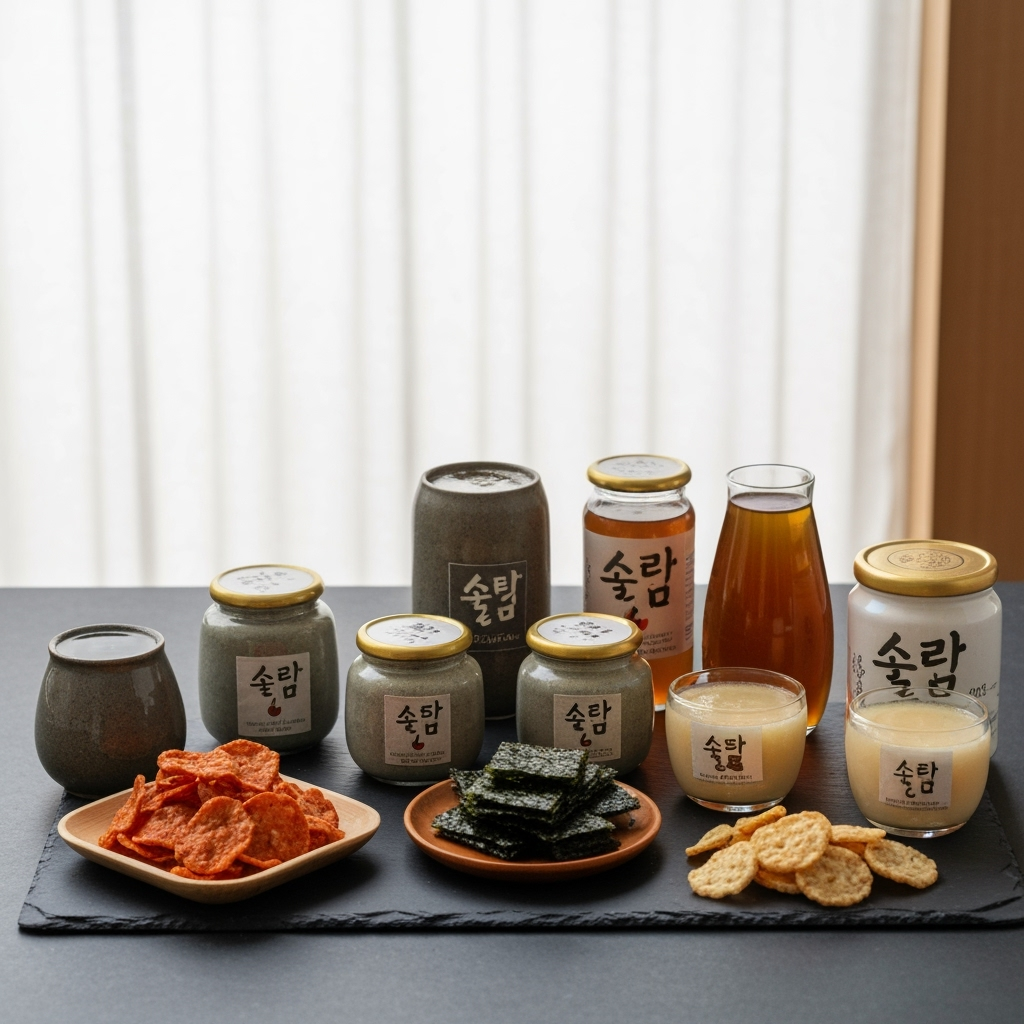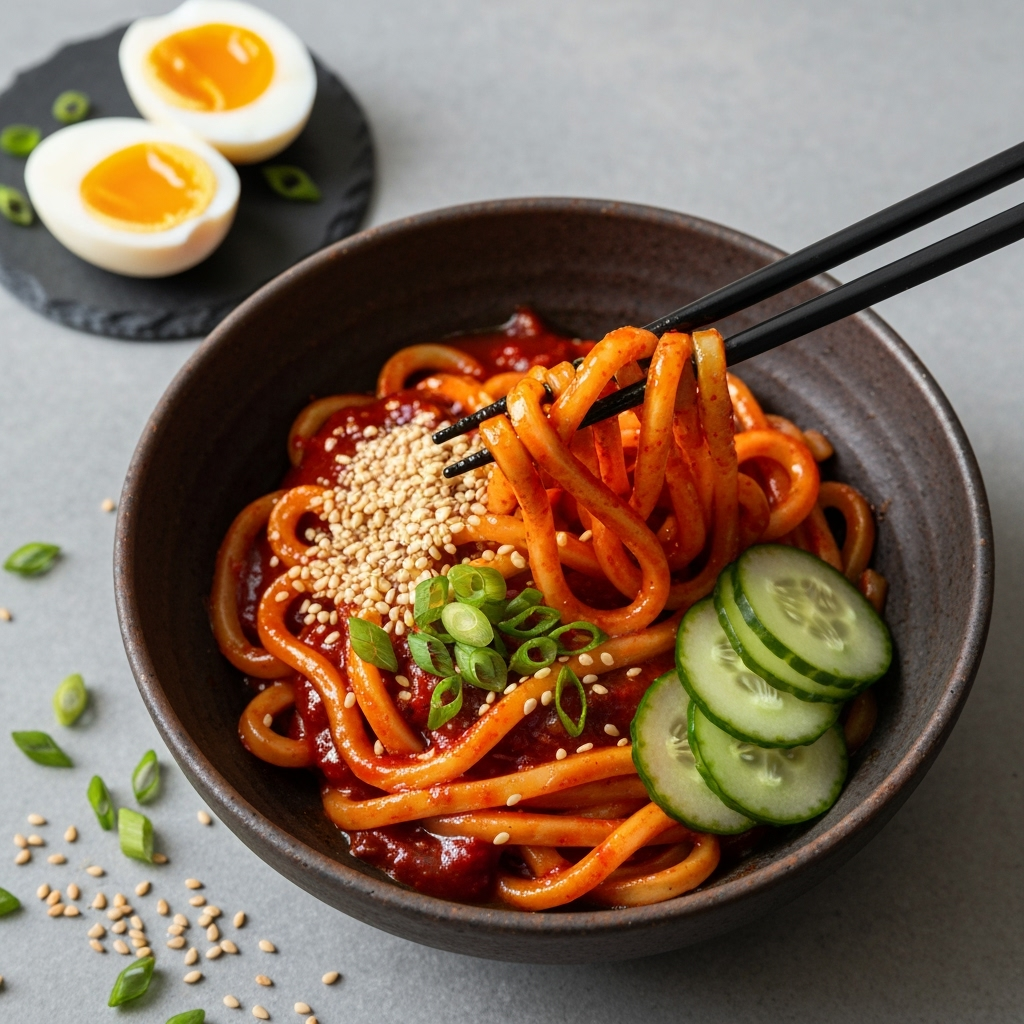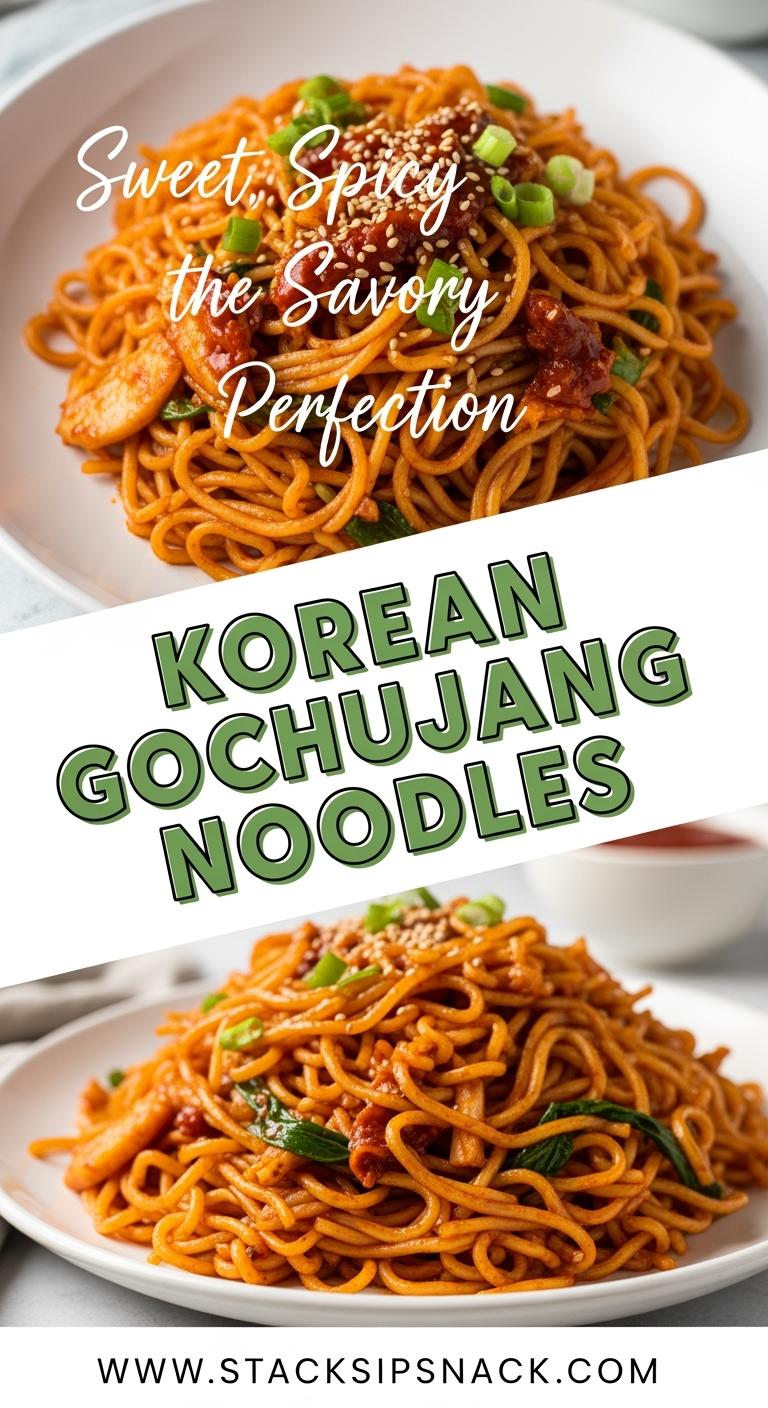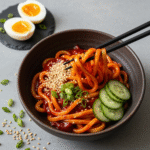Korean Gochujang Noodles are the kind of meal that happens almost by accident, born from a late-night craving and a nearly empty fridge. I remember one particularly chaotic Tuesday, the kids were finally asleep, my husband was traveling for work, and I was staring into the abyss of my pantry. There were udon noodles, a half-empty jar of gochujang, and a sad-looking bell pepper. Thirty minutes later, I was slurping up the most incredibly savory, spicy, and satisfying bowl of noodles I’d had in ages. It was a revelation in simplicity. This dish has since become my go-to for busy weeknights, and I’m so excited to share it with you.
These easy Korean noodles deliver a complex, restaurant-worthy flavor with minimal effort, proving that the best meals don’t have to be complicated.
Table of Contents
Korean Gochujang Noodles Ingredients
Korean Gochujang Noodles start with a handful of simple, flavor-packed components. The magic is in the balance between the sweet, spicy, and savory elements.

- Udon Noodles: 2 packs (about 14 oz total). I love the chewy, substantial texture of udon for this dish. You can find fresh or frozen udon in the international aisle.
- Gochujang Paste: 3 tablespoons. This is the star! It’s a fermented Korean chili paste that’s spicy, slightly sweet, and deeply savory.
- Soy Sauce: 2 tablespoons. Use low-sodium if you’re watching your salt intake.
- Rice Vinegar: 1 tablespoon. This adds a crucial bright, acidic note that cuts through the richness.
- Toasted Sesame Oil: 1 tablespoon. Don’t skip the “toasted” part—it has a much deeper, nuttier flavor.
- Maple Syrup or Honey: 1 tablespoon. A touch of sweetness balances the heat. Agave syrup works for a vegan version.
- Garlic: 3 cloves, minced. Fresh is best for that pungent kick.
- Vegetable Oil: 1 tablespoon, for stir-frying.
- Bell Pepper: 1 large, sliced. I used red for sweetness, but any color works.
- Carrot: 1 medium, julienned or cut into matchsticks.
- Green Onions: 3, sliced, with whites and greens separated.
- Sesame Seeds: For garnish.
Smart Swaps:
- Noodles: Don’t have udon? These Japanese stir-fried udon noodles use the same base, but you can also use ramen noodles, soba, or even spaghetti in a pinch.
- Protein: Add shredded rotisserie chicken, crispy tofu, or a fried egg on top for a more filling meal.
- Veggies: Swap in mushrooms, snap peas, or spinach. Use what you have!
Quick Spicy Noodles Timing
- Prep Time: 10 minutes
- Cook Time: 15 minutes
- Total Time: 25 minutes
That’s faster than waiting for delivery, and you control the spice level.
Step-by-Step Gochujang Noodle Recipe
Making these spicy gochujang noodles is a straightforward process. The key is having your sauce mixed and your veggies prepped before you start cooking.
- Cook the Noodles: Bring a large pot of water to a boil. Cook the udon noodles according to package directions (usually just 2-3 minutes for fresh/frozen). Drain and rinse briefly with cold water to stop the cooking process. Set aside.
- Make the Sauce: In a small bowl, whisk together the gochujang paste, soy sauce, rice vinegar, sesame oil, and maple syrup until smooth. This is your flavor powerhouse.
- Stir-Fry the Aromatics: Heat the vegetable oil in a large wok or skillet over medium-high heat. Add the minced garlic and the white parts of the green onions. Stir-fry for about 30 seconds until fragrant. Be careful not to burn the garlic.
- Cook the Vegetables: Add the sliced bell pepper and julienned carrot to the skillet. Stir-fry for 3-4 minutes until they are just tender but still have a bit of crunch.
- Combine Everything: Add the cooked udon noodles to the skillet. Pour the prepared sauce over the top. Using tongs or two spoons, toss everything together vigorously until the noodles and vegetables are evenly coated in the glorious red sauce. Cook for another 1-2 minutes until everything is heated through.
- Serve Immediately: Divide the noodles between bowls. Garnish generously with the green parts of the green onions and a sprinkle of sesame seeds.
Nutritional Snapshot
A serving of this gochujang noodle recipe provides a good balance. It’s approximately 380 calories, with about 12g of protein, 65g of carbohydrates, and 8g of fat. Gochujang is a fermented food, which can be beneficial for gut health, and the vegetables add a dose of vitamins A and C.
Equipment Needed for Easy Korean Noodles
You don’t need any fancy gear for this recipe. A large pot for boiling noodles, a large wok or skillet for the stir-fry, and a small bowl for mixing the sauce are all it takes. Tongs are helpful for tossing the noodles in the sauce.
Why You’ll Love This Gochujang Noodle Recipe
- Incredibly Fast: From fridge to table in under 30 minutes, making it a perfect weeknight savior.
- Customizable Heat: You control the spice level by adjusting the amount of gochujang.
- Packed with Flavor: It’s a complex, umami-rich dish that tastes like it came from a restaurant.
- Great for Clean-out-the-Fridge: The vegetable mix is highly adaptable.
Healthier Alternatives for Spicy Gochujang Noodles
This recipe is already quite healthy, but you can easily tweak it to fit your dietary needs.
- Gluten-Free: Use tamari instead of soy sauce and ensure your udon noodles are a gluten-free variety (like those made from brown rice).
- Lower-Carb: Swap the udon noodles for zucchini noodles (zoodles) or shirataki noodles. Sauté them briefly at the end to warm through.
- Added Protein: Stir in some edamame or top with a soft-boiled egg. For a heartier, saucier option, try our creamy gochujang udon noodles which incorporate a rich, protein-packed sauce.

Korean Gochujang Noodles Serving Suggestions
These noodles are a complete meal on their own, but they love company. Serve them with a simple side of kimchi for an extra probiotic kick and authentic Korean flair. If you’re feeding a crowd, pair them with Korean fried chicken or some simple steamed dumplings. For a different but equally comforting noodle experience, this katsu curry udon is a fantastic choice.
Common Mistakes to Avoid with This Noodle Recipe
- Overcooking the Vegetables: You want a bit of crunch in your bell peppers and carrots. They should be tender-crisp, not mushy.
- Not Tossing Vigorously Enough: When you add the sauce to the noodles, toss everything very well to ensure every single strand is coated in that delicious, spicy glaze.
- Using Cold Noodles: If your noodles have been sitting and have clumped together, run them under warm water and loosen them with your hands before adding them to the skillet.
Storing Tips for Your Quick Spicy Noodles
Leftovers can be stored in an airtight container in the refrigerator for up to 3 days. The noodles will absorb the sauce, so when reheating, add a splash of water or broth to loosen it up again. I don’t recommend freezing this dish, as the texture of the noodles can become mushy upon thawing.

Your New Go-To Spicy Noodle Conclusion
I truly hope these Korean Gochujang Noodles become a fast favorite in your home kitchen just like they are in mine. They are the perfect solution for when you need a meal that feels special but requires zero fuss. The combination of chewy noodles, crisp-tender veggies, and that addictive spicy-sweet sauce is simply unbeatable. If you love the fiery kick of these, you might also enjoy our quick spicy gochujang noodle soup for a comforting broth-based version.
I’d love to hear how your version turns out! Did you add extra veggies or a different protein? Leave a comment below and tell me all about it. And if you share a photo of your creation, don’t forget to tag @Stacksipsnack on Pinterest so I can see your masterpiece
FAQs
Is Korean gochujang noodles healthy?
Korean gochujang noodles can be part of a balanced diet when prepared mindfully. While gochujang itself contains some sugar and sodium, the overall healthiness depends on the type of noodles, added vegetables, protein, and portion size. Opting for whole wheat noodles, lean protein, and abundant vegetables can enhance their nutritional value.
What kind of noodles do Koreans use for gochujang?
Many types of noodles pair well with gochujang. Common choices include ramyeon (ramen) noodles for a quick, hearty dish, udon noodles for a chewier texture, somen (thin wheat) noodles for lighter preparations like bibim guksu, or even tteokbokki (rice cakes) which are often grouped with noodle-like dishes. Instant ramen noodles are frequently used for convenience.
How do you eat gochujang noodles?
Gochujang noodles are typically eaten with chopsticks, often alongside Korean side dishes (banchan) like kimchi or pickled radishes. They can be enjoyed hot, either as a soupy dish or a stir-fried preparation, or chilled as a refreshing spicy noodle salad, depending on the specific recipe.
What does gochujang taste like with noodles?
When combined with noodles, gochujang imparts a complex flavor profile that is deeply savory, moderately sweet, and distinctively spicy with fermented undertones. The spiciness can range from mild to intense depending on the gochujang variety and amount used, creating a rich and satisfying warmth.
Is gochujang sauce spicy?
Yes, gochujang sauce is inherently spicy, although its heat level can vary. It’s known for its robust, lingering warmth rather than an immediate, sharp heat. Different brands and types of gochujang come with varying spice levels, often indicated on the packaging, from mild to extra hot.
What is the difference between gochujang and gochugaru?
Gochujang is a savory, sweet, and spicy fermented chili paste, thick in consistency, used as a condiment or base for sauces. Gochugaru, on the other hand, is Korean chili powder or flakes, made from dried chili peppers. Gochugaru provides pure heat and vibrant red color, while gochujang offers a more complex, fermented flavor and sticky texture.

Korean Gochujang Noodles
- Total Time: 25 minutes
- Yield: 2 servings 1x
Description
Korean Gochujang Noodles are the kind of meal that happens almost by accident, born from a late-night craving and a nearly empty fridge. These easy Korean noodles deliver a complex, restaurant-worthy flavor with minimal effort, proving that the best meals don’t have to be complicated.
Ingredients
- Udon Noodles: 2 packs (about 14 oz total)
- Gochujang Paste: 3 tablespoons
- Soy Sauce: 2 tablespoons
- Rice Vinegar: 1 tablespoon
- Toasted Sesame Oil: 1 tablespoon
- Maple Syrup or Honey: 1 tablespoon
- Garlic: 3 cloves, minced
- Vegetable Oil: 1 tablespoon
- Bell Pepper: 1 large, sliced
- Carrot: 1 medium, julienned
- Green Onions: 3, sliced
- Sesame Seeds: For garnish
Instructions
- Cook the Noodles: Bring a large pot of water to a boil. Cook the udon noodles according to package directions. Drain and rinse briefly with cold water. Set aside.
- Make the Sauce: In a small bowl, whisk together the gochujang paste, soy sauce, rice vinegar, sesame oil, and maple syrup until smooth.
- Stir-Fry the Aromatics: Heat the vegetable oil in a large wok or skillet over medium-high heat. Add the minced garlic and the white parts of the green onions. Stir-fry for about 30 seconds until fragrant.
- Cook the Vegetables: Add the sliced bell pepper and julienned carrot to the skillet. Stir-fry for 3-4 minutes until just tender but still crisp.
- Combine Everything: Add the cooked udon noodles to the skillet. Pour the prepared sauce over the top. Toss everything together until evenly coated. Cook for another 1-2 minutes until heated through.
- Serve Immediately: Divide the noodles between bowls. Garnish with the green parts of the green onions and sesame seeds.
Notes
Smart Swaps: Don’t have udon? Use ramen noodles, soba, or spaghetti. Add shredded rotisserie chicken, crispy tofu, or a fried egg for protein. Swap in mushrooms, snap peas, or spinach for vegetables. Leftovers can be stored in an airtight container in the refrigerator for up to 3 days. Add a splash of water or broth when reheating to loosen the sauce.
- Prep Time: 10 minutes
- Cook Time: 15 minutes
- Category: Main Course
- Method: Stir-fry
- Cuisine: Korean
Nutrition
- Serving Size: 1 bowl
- Calories: 380
- Sugar: 12g
- Sodium: 800mg
- Fat: 8g
- Saturated Fat: 1g
- Unsaturated Fat: 6g
- Trans Fat: 0g
- Carbohydrates: 65g
- Fiber: 4g
- Protein: 12g
- Cholesterol: 0mg
💬 Let’s Stay Connected!
For daily recipes, kitchen tips, and exclusive content, follow me on:
👉 Facebook for behind-the-scenes & community fun
👉 Pinterest for visual inspiration & meal ideas
👉 X (Twitter) for quick tips & trending recipes
📲 Join the flavor journey, your next favorite recipe is just a follow away!










